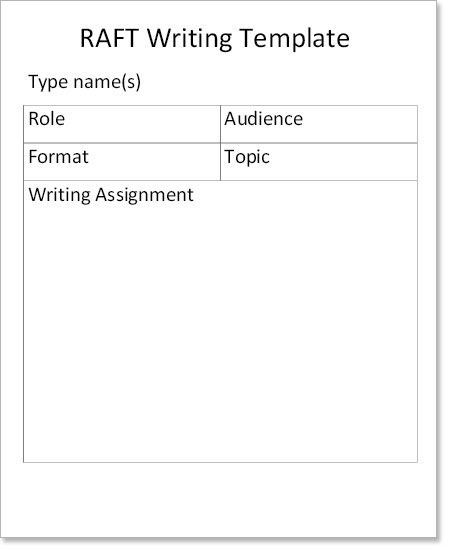Key Information
Focus
Appropriate Group Size
Why use RAFT?
- RAFT includes writing from different viewpoints.
- RAFT helps students learn important writing skills such as audience, main idea, and organization.
- RAFT teaches students to think creatively about writing by responding to the following prompts:
- Role of the writer: Who or what are you as the writer? A pilgrim? A soldier? The President?
- Audience: To whom are you writing? A friend? Your teacher? Readers of a newspaper?
- Format: In what format are you writing? A letter? A poem? A speech?
- Topic and strong verb: What are you writing about? Why? What’s the subject or the point?
- RAFT can be used across various content areas.
How to use RAFT
- Display a completed RAFT example on the overhead.
- Describe each of these using simple examples: role, audience, format, and topic. (It may be helpful to write the elements on chart paper or a bulletin board for future reference).
- Model how to write responses to the prompts, and discuss the key elements as a class. Teachers should keep this as simple and concise as possible for younger students.
- Have students practice responding to prompts individually, or in small groups. At first, it may be best to have all students react to the same prompt so the class can learn from varied responses.
Download blank templates

Watch: Why do writers write? Understanding the purpose for writing
Help students understand purpose and audience in writing by modeling and providing opportunities to practice writing different forms, such as persuasive or explanatory text. (From the Balanced Literacy Diet: Putting Research into Practice in the Classroom)
Collect resources
Language Arts
This site demonstrates using a RAFT to have students write about energy use in transportation. Students are provided a list of Roles, Audiences, Formats, and Topics from which they may choose for their writing assignment. See example ›
Science
This simple example shows how to use RAFT in a discussion about the role of different plant parts. See example ›
Raft Writing Interactive
This site uses technology to assist with RAFT writing assignments. It provides an interactive template for students to type in possible Roles, Audiences, Formats, and Topics. See example ›
Differentiated instruction
For second language learners, students of varying reading skill, and younger learners
- Modify the strategy, so the student learns topic, role, format and audience separately and distinctly. Examples:
- Write a letter to the President of the United States as yourself. What do you want to write about? You choose the topic.
- Write an essay about how the school can do a better job of improving the environment as yourself. Who do you want to write it to?
- Have the student review the concept and assignment orally first. Be sure the student can explain to you what is meant by role, audience, format and topic.
- Use role playing as a method for explaining the different aspects of RAFT writing.
- As students become comfortable in responding to RAFT prompts, you can create more than one prompt for students to respond to after a reading, lesson, or unit. Varied prompts allow students to compare and contrast multiple perspectives, deepening their understanding of the content.
- Students may decide on their own topic or the teacher may provide that element in advance.
See the research that supports this strategy
Mitchell, D. (1996). Writing to learn across the curriculum and the English teacher. English Journal, 85, 93-97.
Santa, C., & Havens, L. (1995). Creating independence through student-owned strategies: Project CRISS. Dubuque, IA: Kendall Hunt.
Children’s books to use with this strategy

The Bunnicula Collection: Books 1 to 3

Are We There Yet? A Journey Around Australia

Flat Stanley: His Original Adventure

Diary of a Worm

Frogs

I Face the Wind

